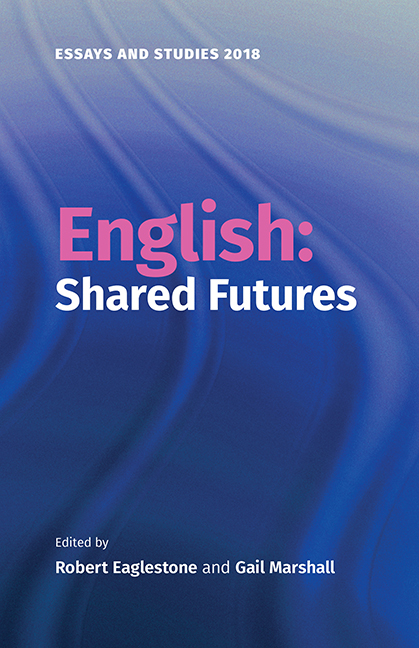Book contents
- Frontmatter
- Contents
- Notes on Contributors
- Acknowledgements
- Abbreviations
- Introduction
- The Changing Picture of School English
- From A-Level to HE: Working Towards a Shared Future?
- English Outreach: Academics in the Classroom
- From Provider to Stager: The Future of Teaching English in HE
- Pedagogic Criticism: An Introduction
- Exquisite Tensions – Narrating the BAME ECA Experience
- Postgraduate Futures: Voices and Views
- Shared Futures: Early Career Academics in English Studies
- Some Reflections on the Funding of English Departments
- English: The Future of Publishing
- Digital Futures
- A View from the United States: The Crisis in the Humanities; the Liberal Arts; and English in the Military Academy
- The Future of Borders
- ‘Between and Across Languages’: Writing in Scotland and Wales
- Exploring Intersections between Creative and Critical Writing: An Interview with Elleke Boehmer
- Integrating English
- Employability in English Studies
- Creative Living: How Creative Writing Courses Help to Prepare for Life-long Careers
- Practice at Large: How Creative Writing can Enhance University Research Environments
- ‘And who can turn away?’ Witnessing a Shared Dystopia
- English and the Public Good
- ‘Can Wisdom be put in a silver rod? / Or Love in a golden bowl?’ On Not Defending the Humanities
- ‘Something Real to Carry Home When Day Is Done’: The Reader in Future
- Afterword
- Index
English and the Public Good
Published online by Cambridge University Press: 15 October 2019
- Frontmatter
- Contents
- Notes on Contributors
- Acknowledgements
- Abbreviations
- Introduction
- The Changing Picture of School English
- From A-Level to HE: Working Towards a Shared Future?
- English Outreach: Academics in the Classroom
- From Provider to Stager: The Future of Teaching English in HE
- Pedagogic Criticism: An Introduction
- Exquisite Tensions – Narrating the BAME ECA Experience
- Postgraduate Futures: Voices and Views
- Shared Futures: Early Career Academics in English Studies
- Some Reflections on the Funding of English Departments
- English: The Future of Publishing
- Digital Futures
- A View from the United States: The Crisis in the Humanities; the Liberal Arts; and English in the Military Academy
- The Future of Borders
- ‘Between and Across Languages’: Writing in Scotland and Wales
- Exploring Intersections between Creative and Critical Writing: An Interview with Elleke Boehmer
- Integrating English
- Employability in English Studies
- Creative Living: How Creative Writing Courses Help to Prepare for Life-long Careers
- Practice at Large: How Creative Writing can Enhance University Research Environments
- ‘And who can turn away?’ Witnessing a Shared Dystopia
- English and the Public Good
- ‘Can Wisdom be put in a silver rod? / Or Love in a golden bowl?’ On Not Defending the Humanities
- ‘Something Real to Carry Home When Day Is Done’: The Reader in Future
- Afterword
- Index
Summary
The phrase ‘English and the public good’ immediately calls to mind the long history of arguments which claim that reading imaginative literature improves us. These arguments can be traced from, for example, Philip Sidney's 1595 ‘Apology for Poetry’, through the Romantics and the Victorians, to modern-day cognitive science and psychology. Sidney argues that stories convey their moral truths through their art, and that this medium exceeds the power of history or philosophy to teach men to act virtuously. Edmund Spenser wrote that the aim of publishing The Faerie Queene was to ‘fashion a gentleman or noble person in vertuous and gentle discipline’. This argument for the moral or improving value of literature is usually in tension with a belief in its aesthetic beauty, creating a conflict between the demand to instruct or educate and the impulse to entertain and delight. This tension can be found in John Dryden's dialogic ‘An Essay of Dramatic Poesy’ (1668), or in the nineteenth-century struggle between didacticism and aestheticism, positions perhaps best denoted by John Ruskin's commitment to the moral value of art and literature on the one hand, and Walter Pater's advocacy of ‘art for art's sake’ on the other. In the twenty-first century, scientists have entered the debate, attempting to provide evidential proof of the morally improving value of literature. In a much-reported article published in Science in 2013, David Comer Kidd and Emanuele Castano claimed to have proved ‘that by prompting readers to take an active writerly role to form representations of characters’ subjective states, literary fiction recruits ToM [theory of mind]’. Very few news outlets reported their qualification – ‘but we see these findings as preliminary and much research is needed’; nor has the media widely covered the fact that in 2016 another group of researchers published an article scientifically challenging Kidd and Castano's claims because the results of their experiments proved not to be replicable.
There is no doubting that Kidd and Castano's intentions were good. Their research and enthusiastic public dissemination of it was clearly driven by a commitment to providing evidential proof to support rhetorical defences of literature. The site of this defence in cognitive science and psychology is, it seems, located in proving the power of literature to improve us by developing our empathetic skills.
- Type
- Chapter
- Information
- English: Shared Futures , pp. 194 - 201Publisher: Boydell & BrewerPrint publication year: 2018

